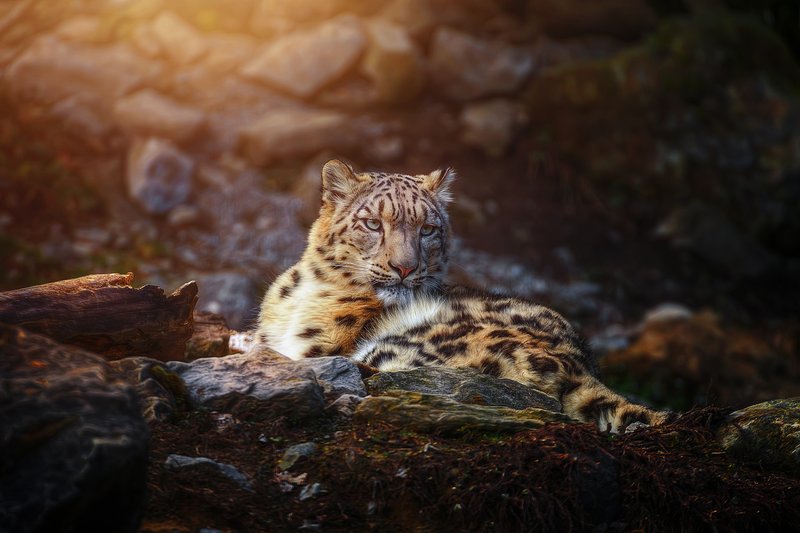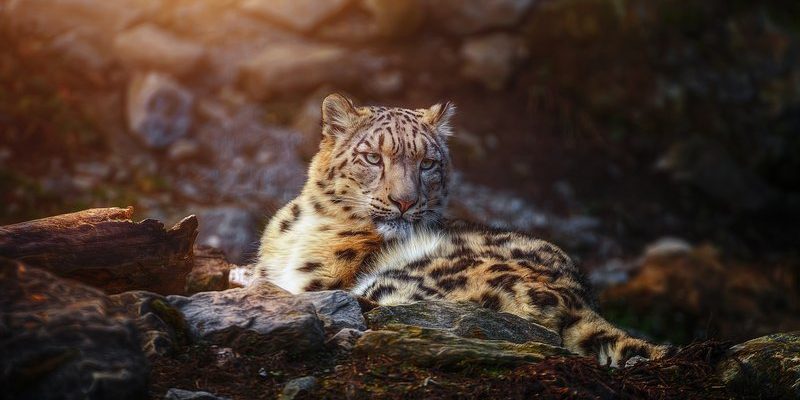
Imagine a shadow lurking in the snowy mountains, its coat shimmering with shades of grey and white. That’s the Snow Leopard, a majestic big cat that roams the high, rugged terrains of Central Asia. Known for its elusive nature and breathtaking beauty, the snow leopard captures the imagination of many who hear about it. But this magnificent creature is more than just a pretty face; it plays a crucial role in its ecosystem, helping to maintain the balance of its mountainous habitat.
Living in some of the harshest environments on Earth, snow leopards have adapted in fascinating ways. They are not only adept at surviving in extreme cold but are also expert hunters, primarily feeding on animals like ibex and sheep. Unfortunately, these incredible cats face many challenges, including habitat loss and poaching, which threatens their survival. So, let’s dive deeper into the world of the snow leopard and discover what makes it so special.
Physical Characteristics
At first glance, the snow leopard offers a stunning display of nature’s artistry. These cats typically weigh between 60 to 120 pounds and can measure around 3 to 4.5 feet in length, with a tail that can be as long as 36 inches. The snow leopard is built for its environment, possessing short legs, a long body, and a thick, furry tail that aids in balance while navigating rocky terrain.
One of the most distinctive features of the snow leopard is its beautiful coat. Its fur is thick and soft, patterned with rosettes and spots that provide excellent camouflage against the rocky, snowy backgrounds they inhabit. This coat not only protects them from the icy winds of their mountainous homes but also allows them to blend seamlessly into their surroundings. This stealthy appearance is crucial for stalking prey.
Additionally, snow leopards have large, fur-covered feet, almost like natural snowshoes, which help them walk across deep snow without sinking. Their keen eyesight, especially in low light, allows them to spot prey from a distance, making them effective hunters. Overall, these adaptations make the snow leopard one of the most stunning yet skilled predators in the world.
Habitat and Range
The snow leopard primarily inhabits the rugged mountain ranges of Central Asia, including the Himalayas and the Tibetan Plateau. These regions are characterized by steep cliffs, deep valleys, and rocky outcrops, providing a challenging yet suitable home for this elusive feline. The snow leopard prefers altitudes between 9,800 to 14,800 feet, where the climate is cold, and the terrain is rough.
These big cats are found in several countries, including Mongolia, Bhutan, Nepal, India, and Pakistan. Interestingly, they tend to be solitary animals, often establishing territories that can range from 80 to 400 square miles. The size of their territory is influenced by the availability of prey and the density of other snow leopards in the area. This solitude allows them to be stealthy hunters, quietly navigating their territory in search of food.
As climate change threatens the snow leopard’s habitat, their range is becoming increasingly fragmented. This makes it more challenging for them to find mates and hunt effectively. Conservation efforts are crucial to protect these stunning creatures and their environment, ensuring that their habitats remain intact for future generations.
Diet and Hunting Behavior
The snow leopard is a carnivore with a varied diet, primarily consisting of mountain goats, sheep, and smaller mammals like marmots. Being an apex predator, they play a vital role in controlling the populations of their prey, which helps maintain the health of their ecosystem. Snow leopards are known to be opportunistic hunters, often taking advantage of the available prey in their range.
These big cats are equipped with impressive hunting skills. They are known for their ability to leap distances of up to 50 feet, allowing them to pounce on unsuspecting prey from a distance. Their long tail helps with balance during these leaps, especially on the rocky surfaces they traverse. Snow leopards typically hunt alone, utilizing their solitary nature to approach their prey stealthily. They often stalk their target, moving quietly and using natural cover to remain unseen.
After a successful hunt, snow leopards are known to cache their food, hiding it under rocks or snow. This behavior not only helps them keep their food safe from scavengers but also ensures that they have access to a meal when prey is scarce. Overall, their hunting techniques and dietary preferences are finely tuned to their environment, making them extraordinary survivors in the harsh wilderness.
Social Structure and Reproduction
Snow leopards are generally solitary animals, coming together primarily for mating. The breeding season typically occurs between January and March, and after a gestation period of about 90 to 100 days, a female snow leopard gives birth to a litter of 1 to 5 cubs. These cubs are born in a secure den, often located in rocky outcrops that provide protection from predators.
Mother snow leopards are incredibly attentive, caring for their young for around 18 to 22 months. During this time, she teaches them essential survival skills, including hunting. The cubs leave their mother at about 1.5 to 2 years old, at which point they must establish their own territories. This solitary lifestyle can be tough, as they have to navigate their environment and find food on their own.
Interestingly, snow leopards communicate through a series of vocalizations, scent markings, and body language, helping them establish territory and attract mates. They can be quite vocal, especially during the mating season, using growls and chuffing sounds to communicate. This complex social structure is vital for their survival.
Threats to Survival
Despite their adaptability and resilience, snow leopards face several threats to their survival, largely driven by human activities. Habitat loss due to farming, mining, and infrastructure development continues to encroach on their mountainous homes. This fragmentation of habitat makes it difficult for them to find food and mates, increasing the risk of inbreeding.
Additionally, poaching poses a significant threat to snow leopards. Their beautiful fur makes them targets for illegal fur trade, while their bones are sometimes used in traditional medicine. Livestock grazing also leads to conflict between humans and snow leopards, as these big cats may prey on livestock, leading to retaliatory killings by herders.
Conservation efforts are underway to protect these magnificent animals. Organizations are working to promote coexistence between local communities and snow leopards, offering compensation for livestock losses and educating villagers about the ecological importance of these big cats. Increasing awareness and support for conservation initiatives is crucial for the future of the snow leopard.
Conservation Efforts
Efforts to conserve the snow leopard have gained momentum in recent years. Many organizations, including the Snow Leopard Trust and the World Wildlife Fund, are dedicated to ensuring the survival of this elusive big cat. These organizations focus on various aspects of conservation, from habitat preservation to research and community engagement.
One significant aspect of these efforts is the establishment of protected areas in key snow leopard habitats. These sanctuaries help safeguard both the snow leopard and its prey, creating a healthier ecosystem. Conservationists are also working on initiatives to reduce human-wildlife conflict by promoting sustainable livestock management practices, which help minimize the likelihood of snow leopards preying on domestic animals.
Moreover, educational programs play a crucial role in raising awareness. By involving local communities in conservation, people are more likely to see snow leopards as valuable members of their ecosystem rather than threats. Community-based conservation strategies empower locals to take an active role in protecting their natural heritage. All these efforts combined are essential to ensure that future generations can experience the wonder of the snow leopard.
Interesting Facts About Snow Leopards
| Scientific Name: | Panthera uncia |
| Weight: | 60 – 120 pounds |
| Length: | 3 – 4.5 feet, excluding the tail |
| Tail Length: | Up to 36 inches |
| Lifespan: | 15 – 18 years in the wild |
| Habitat: | Snowy mountain ranges of Central Asia |
| Diet: | Carnivorous; primarily mountain goats and sheep |
| Conservation Status: | Vulnerable |
FAQ
What is the snow leopard’s primary diet?
The snow leopard mainly feeds on large ungulates, such as ibex and blue sheep. However, they are opportunistic hunters and can also consume smaller mammals like marmots and hares when larger prey is scarce. This adaptability in diet helps them survive in the harsh conditions of their mountainous habitats.
How do snow leopards adapt to their cold environment?
Snow leopards are wonderfully adapted to the cold. Their thick, soft fur keeps them warm, and their large, fur-covered feet act as natural snowshoes, allowing them to walk on deep snow. They also have a layer of fat beneath their skin that provides insulation, ensuring they stay warm even in frigid temperatures.
Are snow leopards social animals?
Snow leopards are not particularly social; they are solitary animals. They generally come together only during mating season and when a mother is raising her cubs. This solitary behavior helps them maintain large territories and minimizes competition for food and resources.
What are the main threats to snow leopard populations?
The primary threats to snow leopards include habitat loss, poaching for their fur, and conflicts with herders who lose livestock to these big cats. Climate change also poses a significant risk, as it affects the ecosystems and prey availability in their mountainous habitats.
How can we help snow leopards?
You can help snow leopards by supporting conservation organizations focused on their protection, spreading awareness about their plight, and promoting sustainable practices that reduce human-wildlife conflict. Additionally, educating others about the importance of snow leopards in maintaining ecological balance can contribute to their conservation.
What is the current conservation status of snow leopards?
Snow leopards are currently listed as Vulnerable by the International Union for Conservation of Nature (IUCN). This status highlights the ongoing threats they face, including habitat loss and poaching, and emphasizes the need for continued conservation efforts to protect their populations.
Can snow leopards and humans coexist?
Yes, coexistence is possible. Conservation programs are working to promote strategies that benefit both snow leopards and local communities. These include providing compensation for livestock losses and educating communities about the ecological role of snow leopards, fostering a sense of stewardship toward this iconic species.
How long do snow leopards live in the wild?
In the wild, snow leopards typically live around 15 to 18 years. However, their lifespan can be longer in captivity, where they are protected from the threats they encounter in their natural habitats.
How fast can snow leopards run?
While snow leopards aren’t the fastest cats in the world, they can reach speeds of up to 30 miles per hour in short bursts. Their agility and strength make them effective hunters, allowing them to leap great distances when pursuing prey.
Do snow leopards have any natural predators?
Adult snow leopards have very few natural predators due to their position as apex predators in their environment. However, young cubs can occasionally fall prey to larger carnivores, such as wolves or other big cats. The biggest threat they face comes from humans and habitat disruption.
What is the significance of the snow leopard in its ecosystem?
Snow leopards play a crucial role in their ecosystem as top predators. They help control the populations of herbivores, which in turn maintains the health of the vegetation in their habitats. By doing so, they contribute to the overall balance of their mountainous environment.

